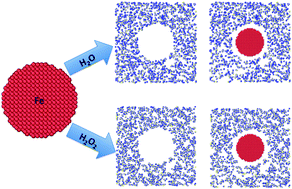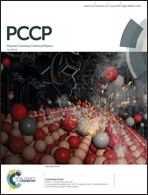Oxyhydroxide of metallic nanowires in a molecular H2O and H2O2 environment and their effects on mechanical properties
Abstract
To avoid unexpected environmental mechanical failure, there is a strong need to fully understand the details of the oxidation process and intrinsic mechanical properties of reactive metallic iron (Fe) nanowires (NWs) under various aqueous reactive environmental conditions. Herein, we employed ReaxFF reactive molecular dynamics (MD) simulations to elucidate the oxidation of Fe NWs exposed to molecular water (H2O) and hydrogen peroxide (H2O2) environment, and the influence of the oxide shell layer on the tensile mechanical deformation properties of Fe NWs. Our structural analysis shows that oxidation of Fe NWs occurs with the formation of different iron oxide and hydroxide phases in the aqueous molecular H2O and H2O2 oxidizing environments. We observe that the resulting microstructure due to pre-oxide shell layer formation reduces the mechanical stress via increasing the initial defect sites in the vicinity of the oxide region to facilitate the onset of plastic deformation during tensile loading. Specifically, the oxide layer of Fe NWs formed in the H2O2 environment has a relatively significant effect on the deterioration of the mechanical properties of Fe NWs. The weakening of the yield stress and Young modulus of H2O2 oxidized Fe NWs indicates the important role of local oxide microstructures on mechanical deformation properties of individual Fe NWs. Notably, deformation twinning is found as the primary mechanical plastic deformation mechanism of all Fe NWs, but it is initially observed at low strain and stress level for the oxidized Fe NWs.



 Please wait while we load your content...
Please wait while we load your content...